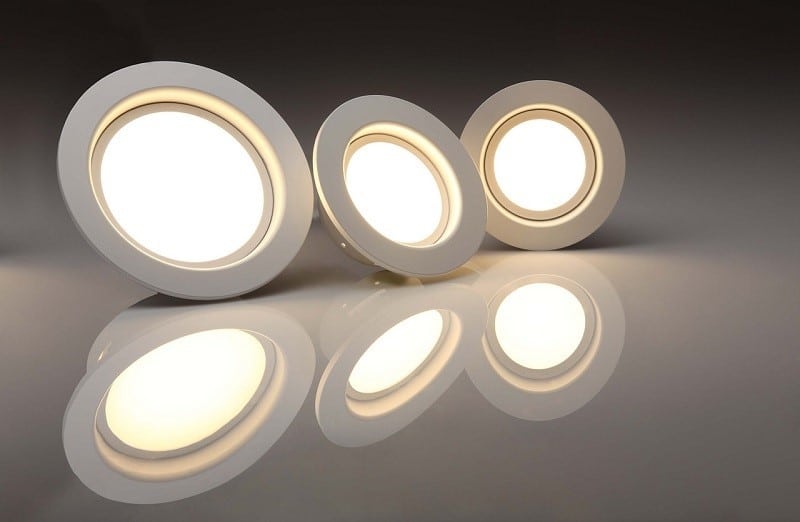The arrival of dependable, energy-efficient lighting in our homes and workplace has and continues to play a significant role in our modern way of life.
The 20th century saw a great improvement in lighting technology. Some of the most exciting lighting technologies invented during this century were High-Intensity Discharge (HID) lamps and the Light Emitting Diode aka LED lighting .
HID lamps include fluorescent, high-pressure sodium, and mercury vapor. HIDs have two metal electrodes and an inert gas-filled glass tube; a current is sent between the electrodes and the tube. On the contrary, LED lighting technology doesn’t use a glass tube. It is categorized as a solid-state light (SSL) and is the main focus of this article.
What Is LED Lighting?
LED lighting is a type of lighting technology where a semiconductor is used to convert electrical current to light. A semiconductor is a solid substance with electrical conductivity between that of a non-conductor and that of most metals. Its conductivity properties are easy to alter by introducing impurities into its crystal structure. The process is known as ‘doping’ and results in a semiconductor junction if two regions of the same crystal are doped. The semiconductor junction is the basis for diodes.
When an electric current is introduced, electrons at one end of the semiconductor junction gain energy and start crossing the gap, recombining with electron holes in turn. The process releases photons in turn. In short, a current is pushed through the semiconductor, and it produces light. The color of the produced light depends on the amount of energy needed by electrons to move past the semiconductor’s bandgap.
History of LED Lighting Technology
The earliest visible-spectrum LED was revealed in 1962 by Nick Holonyak of General Electric; he called his invention ‘the magic one.’
The earliest form of LEDs was low-intensity infrared (IR) lights used in remote-control circuits. These were of low-intensity and red. Later, the technology was improved to produce LEDs that emitted pale green and pale-yellow color. Now, you can find LEDs across the visible U.V. spectrum and I.R.I.R.
Why Buy LED Lights?
LED lighting technology has several advantages over incandescent lighting technology; these include:
- Longer lifetime because they are energy efficient and generate less heat, slowing down burnout.
- Lower energy consumption due to high lumen output per watt. They convert about 70 percent of their energy into light. Also, they emit less CO2 than incandescent bulbs.
- High intensity and brightness and with a wide range of colors. LEDs can emit superb brightness and are available across all U.V.U.V. spectrum.
- Low radiated heat makes them useful in heat-sensitive spaces, such as where the artwork is displayed to prevent fading.
- Instantaneous illumination; you won’t have to wait a moment for LED light bulbs to warm up when you turn them on.
- LEDs produce light in one direction, not all around, and thus reduce wastage. They are also useful in task lighting.
How Long Do LED Lights Last
Present day lighting has continued to improve across the LED spectrum. There are now LEDs that produce pure violet and ultraviolet black light with increased energy efficiency.
Modern LEDs can last 2-4 times more than their average competitors while giving out high-quality light in an efficient manner. Here’s a breakdown of the average rated lifespan of different types of bulbs
- Incandescent bulbs: 750-2000 hrs.
- Fluorescents: 24,000-36,000 hrs.
- CFLs: 8,000-20,000 hrs.
- Halogens bulbs last twice as long as incandescent bulbs.
- LEDs have an average lifespan of about 50,000hrs.
You can ask the bulb manufacturer for your specific bulb’s average rated lifespan and make sure to get the right LED bulb for the job. For example, don’t use a non-dimmable LED bulb in a dimmer. That will reduce its lifespan, plus you can expect flickering and high-pitched noises.
Can You Cut LED Strip Light?
One of the most appreciated modern forms of LED lights for the room is the LED strip light. LED strip lights are long circuit boards with light-emitting diodes mounted on their surfaces. LED strip lights are also referred to as ribbon lights or LED tape. LED strip lights can be used to accomplish various interior design projects. They give a room a warm glow and attractiveness.
One advantage of LED strip light is that they are flexible; they have a robust PCB board with a tape that can be bent around corners. Alternatively, you could just cut them to a length that suits your needs. They usually come with handy little cut lines for this purpose. You can keep the remaining LED tape for use somewhere else in your house.
Do LED Lights Attract Bugs?
Bugs and lighting are a common topic of interest. Bugs love to buzz around light bulbs because they perceive color or want heat. There are ways to minimize bugs around light bulbs. These include the use of sprays, bug zappers, and citronella. But did you know using LED lights will also help reduce bugs dramatically?
Compared to other types of lighting, LEDs don’t attract many bugs. The reason is that LEDs produce little to zero U.V.U.V. lights and are thus less visible to bugs. So, while an LED light bulb might not get rid of bugs from your outdoor completely, it will help reduce the number of these tiny nuisance visitors. Especially if it’s an LED light of warmer color temperature, some LED lights are even designed to attract and kill bugs. These combine an LED light bulb and a bug zapper into one device.
Conclusion
Looking for LED lighting solutions for your home or place of business? Contact CHINT. CHINT is a leading authority in electronic gadgets and equipment. We can design LED lighting solutions to meet your personal preferences as well as local and international standards. Contact us to learn how we can be of assistance.
















